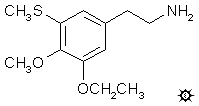
#165 5-TME
5-THIOMETAESCALINE; 3-ETHOXY-4-METHOXY-5-METHYLTHIOPHENETHYLAMINE
|
| [3D .mol structure] |
To a solution of 8.0 g 3-ethoxy-4-methoxy-5-(methylthio)benzaldehyde in 100 mL nitromethane, there was added 0.5 g anhydrous ammonium acetate and the mixture was heated on the steam bath for 1.5 h, at which time most of the aldehyde had disappeared and there was a sizeable quantity of nitrostyrene as well as a cascade of wrong things down to the origin, as seen by TLC on silica gel, with CH2Cl2. The excess nitromethane was removed under vacuum, and the residual red oil was dissolved in 25 mL of hot MeOH and decanted from a small amount of insoluble material. With cooling in an ice bath for 20 min, bright yellow crystals were formed which were removed by filtration, washed with MeOH and air dried, producing 4.1 g 3-ethoxy-4-methoxy-5-methylthio-beta-nitrostyrene which melted at 80-82 °C. This sample, on resolidification and remelting, melted at 109-110 °C. This higher-melting polymorphic form was also produced by recrystallization of the product from cyclohexane. The two polymorphs were chromatographically and analytically identical. Anal. (C12H15NO4S) C,H.
AH was prepared in the usual manner from a suspension of 3.0 g LAH in 100 mL anhydrous THF, cooled to 0 °C, well stirred in an inert atmosphere of He, and treated with 2.0 mL of 100% H2SO4 added dropwise. There was then added a solution of 2.4 g 3-ethoxy-4-methoxy-5-methylthio-beta-nitrostyrene in 20 mL anhydrous THF. The reaction was exothermic, and had come nearly to a boil at the half-addition point. The reaction was cooled again to 0 °C and the remaining nitro-styrene then added. This was brought to a reflux briefly on the steam bath, then cooled again and stirred for an additional 1 h. IPA was carefully added to decompose the excess hydride followed by sufficient 10% NaOH to convert the aluminum oxide to a white, easily filterable mass. This was filtered, the filter cake washed with additional IPA, and the filtrate and washes combined and the solvent removed under vacuum. This was dissolved in 100 mL of dilute H2SO4, which was washed with 2x50 mL CH2Cl2. The aqueous phase was made basic with sodium hydroxide, extracted with 2x50 mL CH2Cl2, and the extracts pooled, dried over anhydrous K2CO3, and stripped of solvent under vacuum to yield a nearly colorless residue. This was distilled at 125-135 °C at 0.3 mm/Hg producing 2.0 g of a water-white oil. This was dissolved in 8 mL IPA, neutralized with 23 drops of con-centrated HCl and, with good stirring, diluted with 20 mL anhydrous Et2O. The product 3-ethoxy-4-methoxy-5-methylthiophenethylamine hydrochloride (5-TME) was removed by filtration, washed with Et2O, and air dried to provide a white solid that weighed 2.0 g and melted at 168-169 °C. Anal. (C12H20ClNO2S) C,H.
DOSAGE: greater than 200 mg.
DURATION: unknown.
QUALITATIVE COMMENTS: (with 200 mg) There was a noticeable tinnitus, but then that comes and goes at odd times without any reason needed. There was perhaps a brush of light-headedness at the third hour point, but other than that, nothing. No effect that can be ascribed to today's drug trial.
EXTENSIONS AND COMMENTARY: Nothing comes to mind. This, along with most of the di- and triethylated thiomescaline analogues, represents a lot of synthetic effort without useful qualitative data. If there is any activity, it would only be seen with monster dosages, and why put the body through such potential impact?
| [ |
[Main Index] | [Forward |

